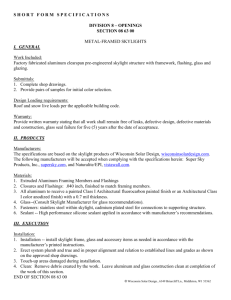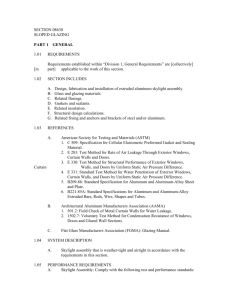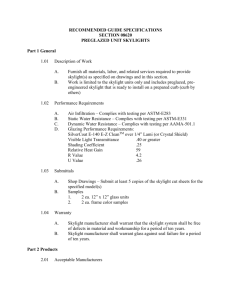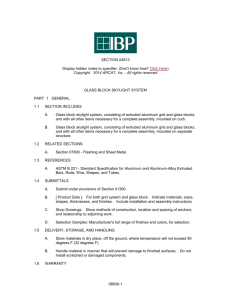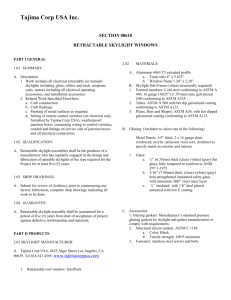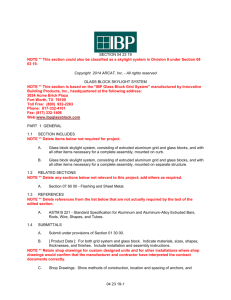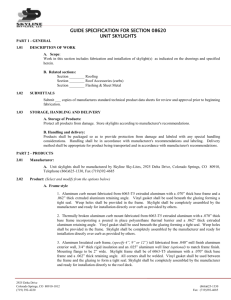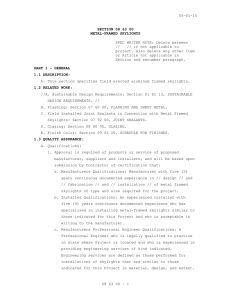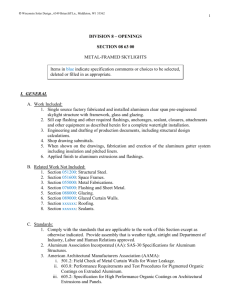LinEl Signature
advertisement
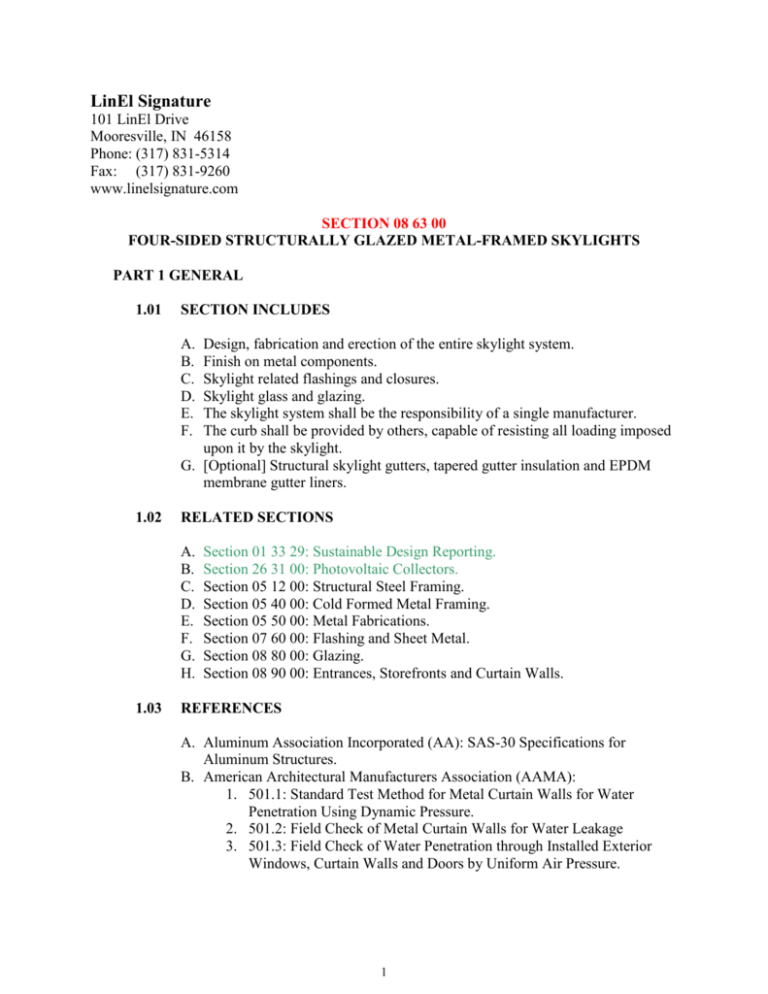
LinEl Signature 101 LinEl Drive Mooresville, IN 46158 Phone: (317) 831-5314 Fax: (317) 831-9260 www.linelsignature.com SECTION 08 63 00 FOUR-SIDED STRUCTURALLY GLAZED METAL-FRAMED SKYLIGHTS PART 1 GENERAL 1.01 SECTION INCLUDES A. B. C. D. E. F. Design, fabrication and erection of the entire skylight system. Finish on metal components. Skylight related flashings and closures. Skylight glass and glazing. The skylight system shall be the responsibility of a single manufacturer. The curb shall be provided by others, capable of resisting all loading imposed upon it by the skylight. G. [Optional] Structural skylight gutters, tapered gutter insulation and EPDM membrane gutter liners. 1.02 RELATED SECTIONS A. B. C. D. E. F. G. H. 1.03 Section 01 33 29: Sustainable Design Reporting. Section 26 31 00: Photovoltaic Collectors. Section 05 12 00: Structural Steel Framing. Section 05 40 00: Cold Formed Metal Framing. Section 05 50 00: Metal Fabrications. Section 07 60 00: Flashing and Sheet Metal. Section 08 80 00: Glazing. Section 08 90 00: Entrances, Storefronts and Curtain Walls. REFERENCES A. Aluminum Association Incorporated (AA): SAS-30 Specifications for Aluminum Structures. B. American Architectural Manufacturers Association (AAMA): 1. 501.1: Standard Test Method for Metal Curtain Walls for Water Penetration Using Dynamic Pressure. 2. 501.2: Field Check of Metal Curtain Walls for Water Leakage 3. 501.3: Field Check of Water Penetration through Installed Exterior Windows, Curtain Walls and Doors by Uniform Air Pressure. 1 4. 603.8: Performance Requirements and Test Procedures for Pigmented Organic Coatings on Extruded Aluminum. 5. 605.2: Specification for High Performance Organic Coatings on Architectural Extrusions and Panels. 6. 606.1: Voluntary Guide Specification and Inspection Methods for Integral Color Anodic Finishes for Architectural Aluminum. 7. 607.1: Voluntary Guide Specification and Inspection Methods for Clear Anodic Finishes for Architectural Aluminum. C. American National Standards Institute (ANSI): Z 97.1 – 1984 – Safety Glazing Materials Used in Buildings – Safety Performance Specifications and Methods of Test. D. American Society for Testing and Materials (ASTM): 1. A193: Standard Specification for Alloy Steel and Stainless Steel Bolting Materials for High Temperature Service. 2. A307: Specification for Carbon Steel Bolts and Studs, 60,000 psi Tensile Strength. 3. B209: Specification for Aluminum and Aluminum Alloy Sheet and Plate. 4. B211: Specification for Aluminum Alloy Bar, Rod and Wire. 5. B221: Specification for Aluminum and Aluminum Alloy Extruded Bars, Rods, Wire, Shapes and Tubes. 6. B316: Specification for Aluminum and Aluminum Alloy Rivet and Cold Heading Wire and Rods. 7. C719: Standard Test Method for Adhesion and Cohesion of Elastomeric Joint Sealants under Cycle Movement. 8. C794: Test Method for Adhesion-In-Peel of Elastomeric Joint Sealants. 9. C1036: Specification for Flat Glass 10. C1048: Specification for Heat Treated Flat Glass – Kind HS, Kind FT Coated and Uncoated Glass 11. D395: Test Methods for Rubber Property – Compression Set 12. D412: Test Methods for Rubber Properties in Tension 13. D1171: Test Method for Rubber Deterioration – Surface Ozone Cracking Outdoors or Chamber (Triangular Specimens) 14. D2240: Test Method for Rubber Property – Durometer Hardness 15. E283: Test Method for Rate of Air Leakage through Exterior Windows, Curtain Walls and Doors. 16. E330: Test Method for Structural Performance of Exterior Windows, Curtain Walls and Doors by Uniform Static Air Pressure Difference. 17. E331: Standard Test Method for Water Penetration of Exterior Windows, Curtain Walls and Doors by Uniform Static Air Pressure Difference. 18. E773: Test Method for Seal Durability of Sealed Insulating Glass Units. 19. E774: Specification for Sealed Insulating Glass Units. 2 20. E783: Method for Field Measurement of Air Leakage through Installed Exterior Windows and Doors E. Consumer Product Safety Commission (CPSC): 16CFR 1202 – Architectural Glazing Standards and Related Material. F. Flat Glass Manufacturers Association (FGMA): Glazing Manual G. Insulating Glass Certification Council (IGCC): Classification of Insulating Glass Units 1.04 SYSTEM DESCRIPTION A. Design Requirements: 1. Extruded aluminum framing with glass that is mechanically fastened with internal retainer clips interlocked with a structurally glazed shopapplied continuous glazing clip and silicone weather seal. Retainer clips are spaced according to structural calculations. 2. Recycled aluminum content in accordance with Section 01 33 29: Sustainable Design Reporting. 3. Snap-in systems are not acceptable. 4. Framing members to have integral gutter system for positive drainage of condensation and infiltration to the exterior. 5. Framing rafters shall have offset gutters to ensure space for moisture migration from horizontal to rafter gutter. 6. Framing horizontals shall be attached to rafters with stainless steel roll pins. 7. Framing horizontals shall have capillary cuts to prevent moisture clinging to the bottom of the horizontal. 8. Glass shelves shall be elevated to protect insulated glass seals. 9. Provide a minimum .050 internal aluminum flashing to direct weepage to the lowest location. Provide a minimum .063 exterior aluminum closure flashing. This double flashing will be designed to create a minimum 4” head height above the weep elevation. Drainage to interior evaporation sill pan flashing is not acceptable. B. Performance Requirements: 1. Structural framing of sufficient sizes to support design loads as prescribed by governing building codes. 2. The deflection of the framing member in a direction normal to the plane of glass when subjected to a uniform load test in accordance with ASTM E330, and per the above specified loads, shall not exceed L/175, up to 1 inch maximum, for clear spans under 20 feet, or L/240 for clear spans greater then 20 feet. 3. The deflection of a framing member in a direction parallel to the plane of glass, when carrying its full dead load, shall not exceed an amount which will reduce the glass or panel bite below 75% of the design dimension and the member shall have a 1/8 inch minimum clearance between itself and the edge of the fixed panel, glass, or component 3 immediately adjacent, nor shall it impair the function of or damage any joint seals. 4. Air Infiltration: Limited to .03 CFM/ft2 when tested in accordance with ASTM E283 at a static pressure of 1.57 psf. 5. Water Penetration: No water penetration shall occur when the system is tested in accordance with ASTM E331 using a differential static pressure of 20% of the inward acting design wind load pressure, but not less than 6.24 psf. Water penetration is defined as the appearance of uncontrolled water other than condensation on the interior surface of any part of the skylight. 6. Condensation Resistance: Condensation Resistance Factor shall be a minimum of 60 at 20% relative humidity with no condensation when tested in accordance with ASTM 1502.7. 7. Drain water penetrating at joints, as well as condensation occurring within the system to exterior face of the work. 8. Thermal Movement: Provide for such expansion and contraction of component materials as will be caused by a surface temperature range of +/- 70 degrees Fahrenheit without causing buckling, stress on glass, failure of seals, undue stress on structural elements, reduction of performance or other detrimental effects. 9. Where permitted by code, a 1/3 increase in allowable stress for wind or seismic load shall be acceptable, but not in combination with any reduction applied to combined loads. In no case shall allowable values exceed the yield stress. 10. The skylight framing is designed to be self-supporting between the structural supporting members. The skylights will impose reactions to the support construction. All adjacent and support construction must support the transfer of all loads including horizontal and vertical, exerted by the skylights. Design or structural engineering services for the supporting structure or building components not included in the skylight scope are not included under this section. 1.05 SUBMITTALS A. Submit shop drawings showing plans, elevations and sections as required to fully describe the skylight construction for the Architect's approval prior to starting fabrication. B. Submit structural calculations prepared by a structural engineer licensed in the state where skylight is to be installed. C. With regard to structural silicone joinery, submit, only if specifically requested: 1. Certification that adhesion of sealant to samples of metal and glass is adequate when tested in accordance with ASTM C794. 2. Certification that materials in contact with sealant are compatible with sealant after being exposed to 2,000-4,000 microwatt ultra-violet radiation for 21 days. 4 D. E. F. G. 1.06 3. Statement that stress on each detailed sealant joint will not exceed design stress of sealant when exposed to specified wind loads. Submit 12-inch square samples of each type of glass. Submit samples of aluminum finish. Submit samples of sealants. Submit one set of as-built drawings, cleaning and maintenance manual upon completion of skylight installation. QUALITY ASSURANCE A. The skylight manufacturer shall be responsible for the design, fabrication, finishing, glazing and installation of the skylight assembly. B. Only factory trained mechanics shall be utilized for the installation of the skylight. C. The skylight manufacturer shall be regularly engaged in custom skylight construction and show proof of similar projects completed over the past ten years. 1.07 WARRANTY A. The system shall be warranted for a period of ten years from the date of skylight completion against leakage, defective design and defective materials. B. Glass is warranted per the manufacturer’s standard warranties regarding delamination, seal failure and coating failure. C. Anodized aluminum finish is warranted per the supplier’s standard warranty. D. Painted aluminum finish is warranted per LinEl Signature’s standard ten-year or optional twenty-year warranty. E. Warrant structural sealant for a period of ten years per sealant manufacturer's standard warranty of merchantable quality. Warranty shall certify that cured sealant: 1. Will not become brittle or crack due to weathering or normal expansion and contraction of adjacent surfaces. 2. Will not harden beyond a Shore A durometer of 50, nor soften below a minimum of 10 points. 3. Will not change color significantly when used with compatible backup materials. 4. Will not bleed significantly. F. Warranty service becomes effective following full payment of the contract amount. PART 2 PRODUCTS 2.01 MANUFACTURERS A. Basis of design: 1. The SG 1000 System manufactured by LinEl Signature. 5 a. LinEl Signature, 101 LinEl Drive, Mooresville, IN 46158; Phone: (317) 831-5314, Fax: (317) 831-9260; Website: www.linelsignature.com. 2.02 MATERIALS A. Extruded aluminum framing members shall have minimum mechanical properties equal to or greater than 6063T-6 alloy. B. Material may contribute towards LEED Compliance MR Credit 2.1/2.2, MR Credit 4.1/4.2, EQ Credit 4.1 and EQ Credit 8.1/8.2. C. Glass clips and clip retainers shall have minimum mechanical properties equal to or greater than 6063T-6 alloy. D. Flashing: 1. Aluminum sheet shall be the required alloy and temper to make compatible with the specified finish, with a minimum thickness of .063". E. Fasteners: 1. Weather Exposed Fasteners: ASTM A193 B8 300 series stainless steel. 2. Framing connection fasteners and anchoring of frame to supporting structure: ASTM A307 zinc-plated steel fasteners. F. Glazing Gaskets: 1. Interior: Silicone dense a. Hardness: ASTM D2240 Shore "A" 60 +/- 5 Durometer. b. Tensile Strength: ASTM D412 1500-1600 psi. c. Elongation: 250-300% d. Color: Black. G. Setting Blocks: 1. Extruded Type II silicone block to be compatible with glazing type. a. Hardness: Shore "A" 80 +/- 5 Durometer. H. Sealant: 1. Structural Flush Glazed Joints: High performance medium modulus silicone sealant applied in accordance with manufacturer’s recommendations. 2. Structural silicone sealant performance requirements as cured after 14 days at 77°F (25°C) and 50% relative humidity. a. Hardness: ASTM D2240 Type A, 30 durometer b. Tensile Strength at 150% Elongation: ASTM D412-80psi. ASTM C719, +/-50%. c. Peel Strength: ASTM C794, 32 lb./in. d. Color: Manufacturer’s standard 3. Perimeter Flashing Sealant: a. Hardness: TT-S-00230C Shore "A" 25 +/- 5 Durometer. b. Tensile Strength: ASTM D412-80 180 psi. c. Adhesion-in-Peel: TT-S-00230C 20-28 lbs./in. d. Ultimate Elongation: ASTM D412-80 550%. 6 I. Finish: (Specifier Edit) 1. PPG Duranar® fluoropolymer (Kynar 500®) shall be a two-coat system consisting of an inhibitive primer and a color topcoat and shall comply with AAMA 605.2. 2. PPG Duranar XL® fluoropolymer shall be a three-coat system consisting of an inhibitive primer, a color coat, and a clear topcoat and shall comply with AAMA 605-2. 3. PPG Duracron Super 600 shall be an acrylic enamel one-coat finish (recommended for interior surfaces only). 4. Manufacturer to have AAMA certified EPA compliant in-house paint application facility. System to be painted after fabrication to the greatest extent possible. 5. Manufacturer to have in-house spectral analyzer for assistance when considering custom or exotic colors. Contact factory for assistance. 6. Anodized Finish: a. AAMA 607.1 Architectural Class I Clear Anodized Type AAM10C22A41. 215R-1 b. Class II Clear Anodized Type AA-M10C22A31. 204R-1 c. AAMA 606.1 Architectural Class I Pigmented Anodized Type AA-M10C22A42 (Specify): [311 Light Bronze] [313 Dark Bronze] [315 Black]. J. Glazing: 1. Glazing should be chosen with regard to local building codes, performance, durability, and aesthetics. A full range of colors and coatings are available. Thickness and state to be determined by manufacturer based on design requirements. See section 088000 Glazing for project specific requirements. 2. Options: a. Laminated glass. b. Insulating laminated glass. c. Electrochromic glass. d. Thermochromic glass. e. Photovoltaic glass. 2.03 FABRICATION A. To the extent possible, fitting and assembly of the work shall be done in the manufacturer’s shop. Work that cannot be shop assembled shall be properly marked before shipment to the job site to assure proper assembly in the field. B. All visible welds shall be smooth and continuous for an anodized finished project or ground to a 100-grit finish for painted projects. 7 C. Attach Glazing clip retainers using stainless steel fasteners into a system of alternate serrations, at a maximum spacing of 12” on center. D. Use silicone setting blocks to support glass and to provide proper edge clearance and glass bits, in accordance with FGMA guidelines. 1. Set blocks not less than 6” from edge of glass for proper support. 2. Glass bite not less than ½” nor more than ¾” on any side of the glass. E. Place weep holes at curb to positively drain condensation to exterior of skylight at each rafter to curb connection at the base of the slope. Apply 30ppi baffle filler material at all weep holes. PART 3 EXECUTION 3.01 INSPECTION A. Prior to starting installation, the skylight erector shall inspect related construction to verify proper preparation in accordance with the approved shop drawings. No work shall proceed until all errors and deviations are corrected. Notify the construction authority having jurisdiction of unacceptable conditions. 3.02 INSTALLATION A. The skylight shall be erected and glazed by an experienced and authorized installer familiar with the manufacturer’s systems and installation procedures. B. Upon completion of installation, installer will leave all aluminum and glazed surfaces free of streaks and smudges. Weep system shall be clean and free of obstruction. C. The manufacturer shall provide instructions to the General Contractor for cleaning of all surfaces. D. Protection and final cleaning shall be the responsibility of the General Contractor. E. Furnishing of temporary covering and weather-proofing of the skylight openings, if required, is by the General Contractor, and removal of the protective measures during and after the skylight installation is excluded by the manufacturer and the manufacturer’s erector. Temporary covers shall not interfere with the installation of the skylight in any way. F. Protection of persons or property below the skylight will be provided by the general contractor, including barricades and traffic control. 3.03 TOLERANCES A. All parts of the work, when completed, shall be within the following tolerances: 1. Maximum variation from plane or location shown on approved shop drawings: 1/8-in. per 12-ft. length, or 1/2-in. in total length. 8 2. Maximum offset from true alignment between two members abutting end-to-end, edge-to-edge in line or separated by less than 3-in.not to exceed 1/32-in. END OF SECTION 9
